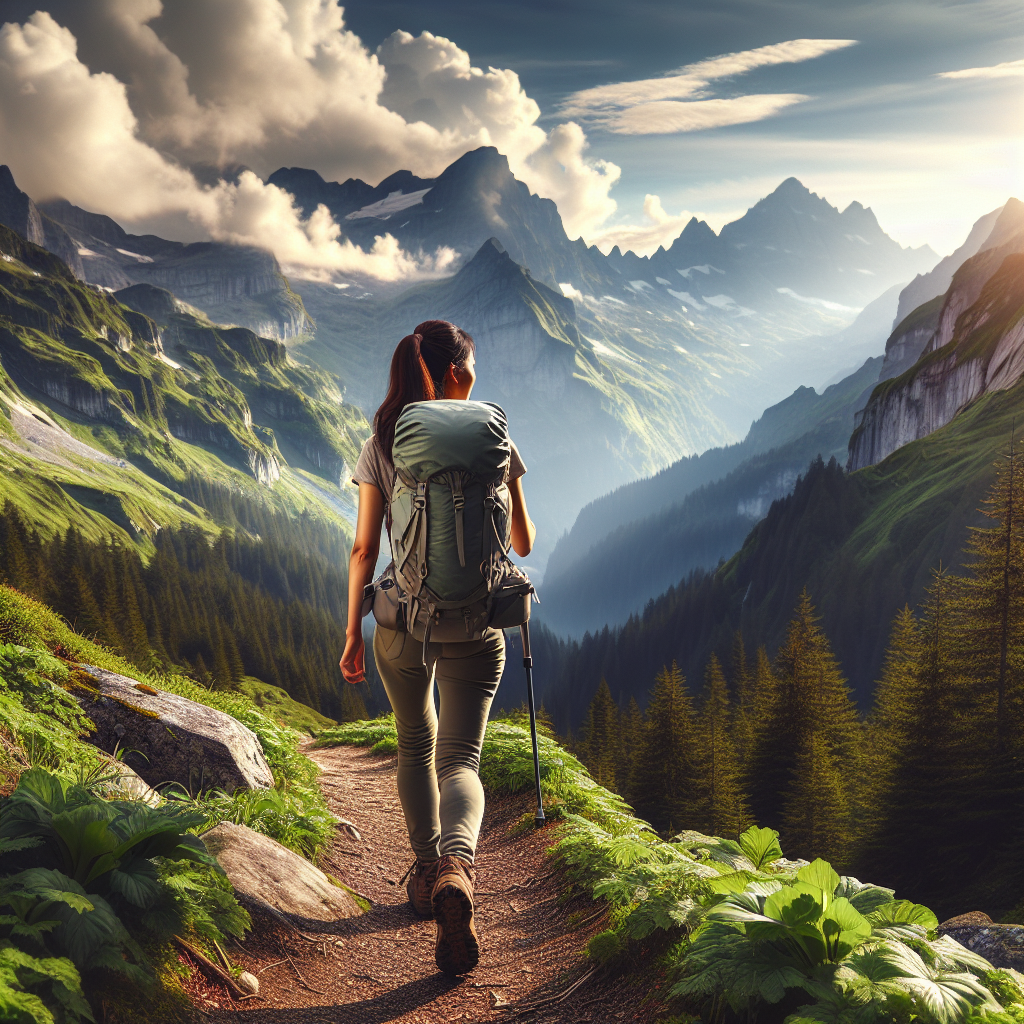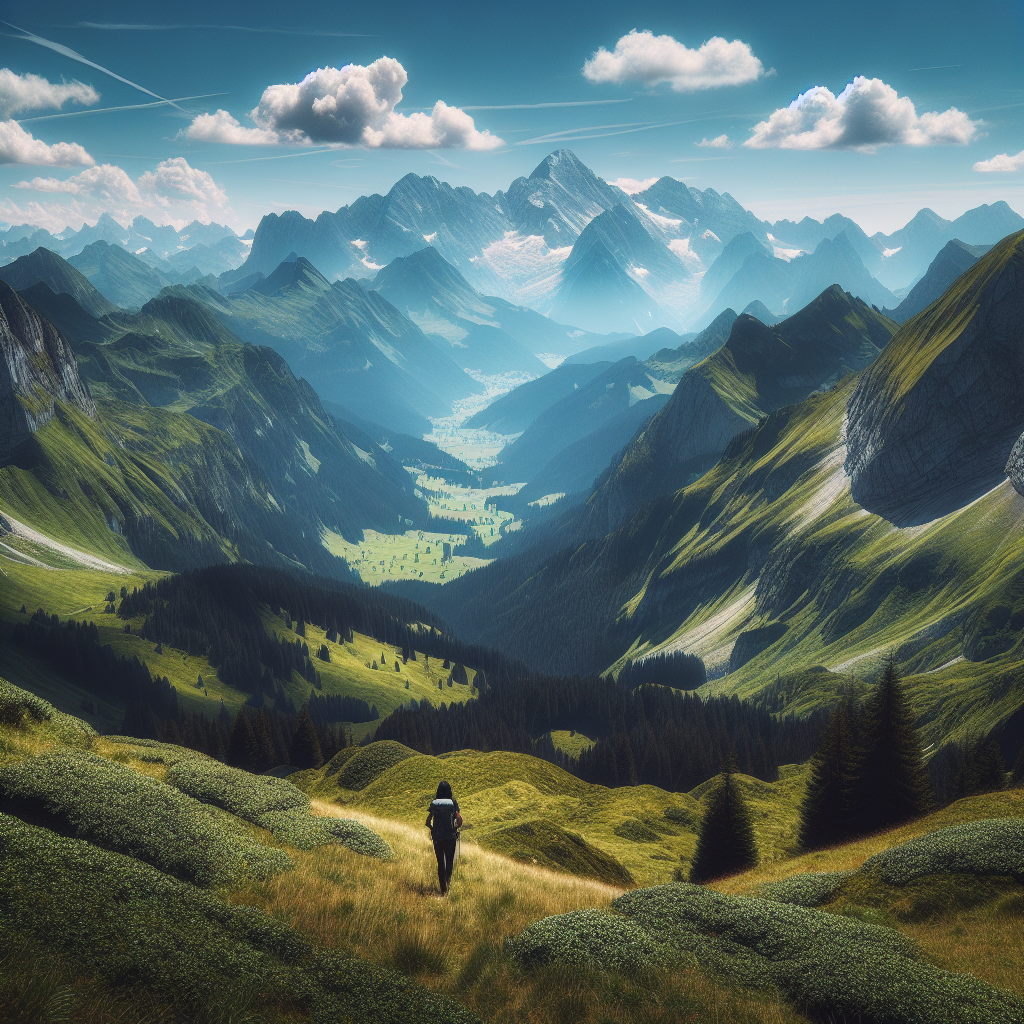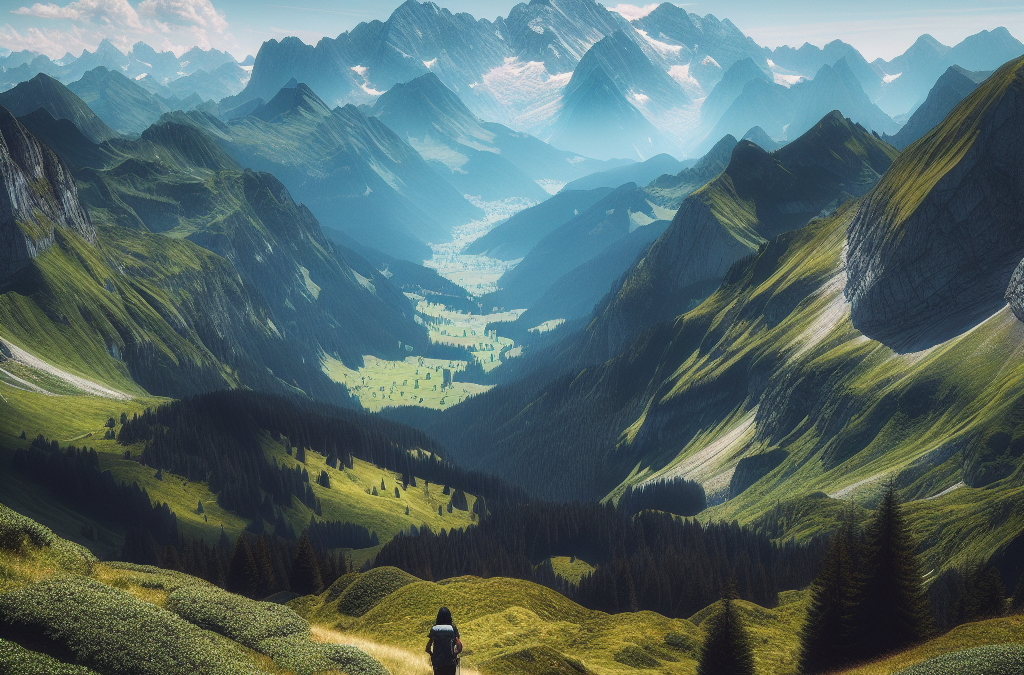Set foot on a majestic voyage without leaving your armchair as you pore over “Hiking In The Alps: Europe’s Majestic Trails”. This riveting essay is your roadmap to experience firsthand Europe’s breathtaking trails, offering a mental escape to the picturesque landscapes that make the Alps a hiker’s paradise. As a reader, you’ll virtually wander through sun-kissed meadows, climb snow-clad peaks, and traverse crystal-clear streams. So, buckle up for a thrilling journey, which will make your adventurer’s spirit yearn for the intoxicating freedom of hiking in the enchanted wilderness of the Alps!

Understanding the Geography of the Alps
It’s a breathtaking experience to hike through the stunning and mighty Alps, which wrap around eight European countries. This mountain range cuts across Europe from west to east, marking a natural boundary for several nations. However, to truly appreciate your journey, it helps to understand the geography and life of the region.
The formation of the Alps
The Alps, Europe’s majestic mountain range, were formed over millions of years. Through a dramatic and forceful process of tectonic collision, the African and Eurasian plates pushed together, resulting in the vertical upliftment and creation of these beautiful mountains.
Overview of Alpine countries
The Alps stretch through a multitude of countries, including France, Italy, Switzerland, Austria, Germany, Slovenia, Liechtenstein, and Monaco. Each country offers its unique Alpine experience. From snowy summits in Switzerland to the charming Alpine villages in Austria, and from the picturesque Italian valleys to the lush forests in Germany, diversity is the true beauty of this mountain range.
Conservation and ecological diversity in the Alps
The Alps are not just known for their towering peaks; they’re also notable for their bio-diversity and conservation efforts. From edelweiss to alpine ibex, rare and wonderful species of plants and animals reside in this ecosystem. A range of national parks, notably Aigüestortes in Spain and Berchtesgaden in Germany, are dedicated to preserving this precious ecosystem.
Preparing for Hiking in the Alps
As a prospective hiker in the Alps, thoughtful preparation is a must. This includes fitness training, possessing the right equipment, and adjusting to Alpine altitudes.
Physical training and conditioning
Given the epic and challenging terrain, it’s important to ensure that you are in excellent physical condition. Starting a regular exercise routine focusing on cardiovascular strength and leg muscle development, several weeks prior to the hike, is beneficial. Distance walking, stair climbing, and strength exercises will help to prepare your body for the trek.
Necessary hiking gear and equipment
A proper hiking gear is the difference between an amazing hike and a struggle up the mountain. Always remember to pack sturdy boots, waterproof clothing, multiple layers for temperature changes, hats, gloves, and sunglasses. Carry essential tools such as a compass, maps, and a first-aid kit. The cold Alpine weather demands a reliable sleeping bag, a camping stove, and high-energy snacks.
The importance of acclimation before Alpine hikes
In the Alps, altitudes can exceed 4,000 meters. It’s crucial to spend a few days at a lower altitude before starting the hike, to mitigate the risk of altitude sickness. Stay hydrated and take regular rests to allow your body to adjust to the reduced oxygen levels.
Best Time to Hike the Alps
Deciding which season to hike in depends greatly on your personal preferences. Do you prefer the lush green landscapes of summer or the glacial beauty of winter?
Summer hiking vs Winter hiking
Summer season offers warm and stable weather, and the wildlife and flora are in full bloom. It’s the perfect time for hikers who enjoy long daylight hours and want to avoid snow-covered paths. Winter hiking, on the other hand, is perfect for those loving the challenges and dramatic snowy landscapes. Be ready for shorter daylight hours and harsh weather conditions in winters.
Understanding Alpine weather patterns
Alpine weather can be unpredictable, so understanding the patterns is essential. Summers can bring increased thunderstorms, whilst the winter season can lead to sub-zero temperatures and heavy snowfall.
Busy periods and off-peak times
The trails tend to be busiest during summers, particularly in July and August. If you prefer quiet trails, consider hiking in the shoulder seasons of late spring and early autumn.
Top Hiking Trails in the Alps
The Alps offer several magnificent trails. Some of the best ones are listed below.
Tour du Mont Blanc
This iconic trail takes on a circular route around Mont Blanc massif. It offers wonderful views and crosses three countries – France, Italy, and Switzerland. It’s typically completed in 11 days.
The Adlerweg trail
Situated in Austria, the Adlerweg trail spans over 280 km. Named after the Austrian eagle, the hike offers a birdseye view of Austria’s diverse landscapes, from steep peaks to verdant valleys.
The GR5 trail
Starting from the Netherlands and ending at the Mediterranean Sea, the celebrated GR5 trail traverses through the heart of the French Alps and is particularly suited for experienced hikers.
The Haute Route
Originating in Chamonix, France, and finishing in Zermatt, Switzerland, the Haute Route is an epic journey like no other. It involves crossing 11 high passes over two weeks.
The Alta Via trails
The Alta Via trails in the Italian Alps are among the most exquisite. With diverse flora and fauna, exceptional food and drink, and superb mountain views, the trails offer trekkers a beautiful and engaging journey.

Safety While Hiking in the Alps
Hiking in the Alps, while stimulating and awe-inspiring, can also be demanding and potentially dangerous. Understanding and observing certain safety measures is crucial.
Dealing with altitude sickness
altitude sickness or mountain sickness is a significant safety concern. Symptoms can range from mild headaches and tiredness to severe breathlessness. Like any medical condition, prevention is better than cure. Remember to acclimate before commencing your hike and hydrate continuously.
Wildlife precautions
The Alps are home to several wildlife species such as marmots, ibex, and eagles. They generally tend to avoid humans, but it’s better to be cautious and maintain a distance.
Navigational challenges
The trails are generally well-marked in the Alps. However, you should always have a map and compass for backup. In more remote areas, a GPS device could be a lifesaver.
Emergency services and supports
Knowing the local emergency numbers is crucial. In some parts of the Alps, mountain rescue teams are available for support. Don’t forget to pack your first-aid kit.
Ecotourism and Sustainable Hiking Practices
Ecotourism implies conscientious traveling that respects nature, sustains the environment, and benefits local communities.
Leave no trace principles
Adhering to the “Leave no trace” principles ensures that the pristine nature of the trails is preserved for future generations. This includes disposing of all waste properly, minimizing campfire impacts, and avoiding disturbing wildlife.
Appreciating local flora and fauna
The Alps are biologically diverse, offering an extensive range of plant and animal species. While hiking, it’s important to observe the wildlife from a distance and avoid picking any native plants.
Supporting local communities and economies
Staying at local lodging, eating at local restaurants, and purchasing locally made goods can greatly benefit the local economy. It fosters a sense of community and goodwill.
Experiencing the Culture of the Alps
Even beyond hiking, the Alps have much to offer in terms of rich culture and tradition.
Alpine food and cuisine
Most of the Alpine countries share similarities in their cuisine. Popular regional recipes include Raclette and Fondue. Make sure to try local delicacies along your hike.
Local customs and traditions
Every Alpine region has unique customs and traditions to explore, from the cow parades in Switzerland to the vibrant masquerade carnivals in Italy. Participating in these local events would provide a unique cultural immersion.
Enjoying Alpine music and festivals
Music and festivals form an integral part of the Alps. The melodious sound of the Alpine horn or yodeling is a unique experience. Taking part in festivals like Fasnacht Day in Switzerland or Oktoberfest in Germany would enrich your journey.
Overnight Hiking and Accommodation Options
The Alps offer numerous accommodation options for overnight hiking.
Mountain huts and shelters
Managed by the local Alpine clubs, these huts provide the basic comforts of a bed and hot meals. Staying at these huts also provides a chance to meet fellow hikers.
Camping regulations and best practices
Certain regions in the Alps only permit overnight camping at designated sites. Always research before planning to camp outdoors and always adhere to “leave no trace” principles.
Rental chalets and lodges
For a more comfortable experience, there are rental chalets and lodges available. Many of these lodgings offer amenities like a private bathroom, a fully equipped kitchen, and laundry facilities.
Hiking with Guided Groups vs. Independent Hiking
Whether to hike independently or with a guided group largely depends on your personal comfort and experience.
Benefits of guided Alpine tours
Guided hikes offer the benefits of a planned itinerary, accommodation arrangements, and a knowledgeable guide who can share interesting facts about the region.
Resources for independent hikers
For experienced hikers seeking solitude and flexibility, hiking independently is a preferred choice. Maps, guidebooks, and digital resources are available to help you plan your perfect hike.
The importance of respecting local guidelines
Whether you’re hiking independently or with a group, it’s crucial to obey local rules and guidelines to ensure your safety and to preserve the beauty of the Alps.
Impact of Climate Change on the Alps
The effects of climate change are tangible in these breathtaking landscapes.
Melting glaciers and shifting landscapes
Glaciers are integral to the Alpine landscape. Sadly, the warming climate is causing these beauties to melt at an unprecedented rate, altering the region’s landscape and ecology.
Threat to Alpine flora and fauna
Warmer temperatures are pushing plant and animal species upwards in search of cooler habitats, putting them at risk of extinction. This potentially threatens the rich biodiversity of the region.
How hikers can help minimize their impact
Hikers have a role to play in minimizing the impact of climate change on the Alps. This includes practicing sustainable travel habits, like using reusable water bottles, reducing waste, and offsetting carbon emissions if possible.
Hiking in the Alps can be one of your most unforgettable experiences. If you plan and prepare well, respect the local customs and rules, and are aware of the environmental issues, you’re all set to enjoy Europe’s majestic trails. Remember, every step counts not only towards reaching the peak but also towards preserving these magnificent mountains for the future. Happy hiking!

